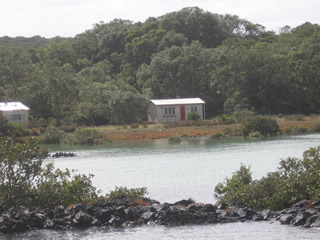A volcano – and some bees…
Julie and Raf suggested that I check out Rangitoto, a dormant volcano and Auckland’s youngest (it was created about 600 years ago). They hadn’t been there yet themselves, but they had heard that the walk up the volcano was good and the views of the city from the top would be worth the trek up there.
The day I decided to go was one of the few days that I haven’t been travelling, so I was a big sluggish (needed a break from moving far distances over a short span of time!). So taking the ferry over to Rangitoto Island seemed like a good idea (the pier for the ferry is a very short walk from Julie and Raf’s place, and the ferry ride itself only takes about 40 minutes).
It ended up being a perfect day for a walk up a volcano. The sun was shining and it was warm, but not too hot. A large group of elementary school students was also there, so I let the kids get a head start and then followed up the trails behind them.
The walk was much more strenuous than I had expected! It’s not very steep, but the incline is such that it really tired me out. I kept running into the other stragglers who had let the school group pass them, and then I found out that one of the stragglers was giving up (it was just too much for her, so she headed back down to wait for the ferry).
By the time I reached the crater and the summit, I was tired and hungry. I joined the school group and took out my lunch. At the bottom of the volcano, signs warned about the presence of bees at the top. And those warnings weren’t false – the bees loved being near the students, and our food! I’m not really afraid of bees, but I get very panicked when I’m eating and they won’t leave me alone.
Anyway, it took a while for me to finish eating (I had to keep getting up and moving around to try to lose the very curious bees) so the school group was gone by the time I was ready to walk around the rim of the crater and start the decent. I had put my bags down while I was eating and then noticed that there was a bee on the water bottle that Julie had lent me. I didn’t want to abandon the bottle up there, so I found a way to shake the bag and get the bottle free (I also really wanted the water that was in it!).
The bee then found something much more interesting inside the bag, and really made himself comfortable. I didn’t want to leave the plastic bag there, either, not because I needed it but because I didn’t want to litter. So I waited. When I figured the bee was gone (I couldn’t see it anymore, and I’d kicked the bag a little to check) I picked the bag up and started walking over to the crater.
Suddenly, there was a bee on my hand (nestled between my ring finger and my pinky)! I freaked out, dropped the bag, and started trying to get the bee off my hand. Man, I never knew bees were so sticky. Somehow I managed to get the bee off without getting stung or killing the bee (how, I’ll never know) and it dived right back into the plastic bag. I poured some of my water on the bag to try to get the bee to leave, but that didn’t do anything. I realized that, if anything, my efforts were just making the bee more angry so I decided to cut my losses and leave the top of the volcano. Who wants to be alone at the top of a volcano with an angry (and possibly vengeful) bee?
So I started a brisk walk around Rangitoto’s crater. The volcano has been dormant for so long that there is a lot of vegetation inside the crater (I hadn’t expected this). And by vegetation, I don’t just mean grass. There are tonnes of trees – it’s like looking into a very shallow valley rather than into a hole that once shot out lava and rocks.

I made it back to the meeting spot for the ferry on time (thank goodness!), put a small donation in the box to ease my conscience and hopefully make up for leaving litter behind, and took at look at some of the historic baches along the coast. A bach (sounds like ‘batch’) is a beach house, sort of like a cottage. Families own them and pass the ownership through generations. The baches on Rangitoto Island were controversial, I think because the land became national park land and then it was an issue for people to own property there.
